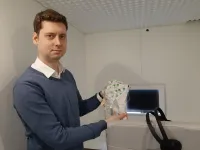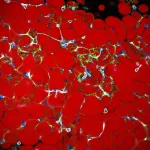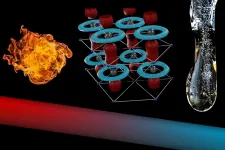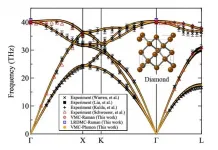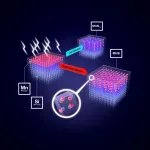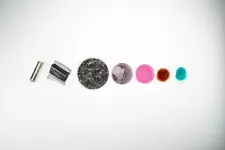(Press-News.org) A team of Nanyang Technological University, Singapore (NTU Singapore) researchers has designed a 'smart' device to harvest daylight and relay it to underground spaces, reducing the need to draw on traditional energy sources for lighting.
In Singapore, authorities are looking at the feasibility of digging deeper underground to create new space for infrastructure, storage, and utilities. Demand for round-the-clock underground lighting is therefore expected to rise in the future.
To develop a daylight harvesting device that can sustainably meet this need, the NTU team drew inspiration from the magnifying glass, which can be used to focus sunlight into one point.
They used an off-the-shelf acrylic ball, a single plastic optical fibre - a type of cable that carries a beam of light from one end to another - and computer chip-assisted motors.
The device sits above ground and just like the lens of a magnifying glass, the acrylic ball acts as the solar concentrator, enabling parallel rays of sunlight to form a sharp focus at its opposite side. The focused sunlight is then collected into one end of a fibre cable and transported along it to the end that is deployed underground. Light is then emitted via the end of the fibre cable directly.
At the same time, small motors - assisted by computer chips - automatically adjust the position of the fibre's collecting end, to optimise the amount of sunlight that can be received and transported as the sun moves across the sky.
Developed by Assistant Professor Yoo Seongwoo from the School of Electrical and Electronics Engineering and Dr Charu Goel, Principal Research Fellow at NTU's The Photonics Institute, the innovation was reported in the peer-reviewed scientific journal Solar Energy early this month.
The device overcomes several limitations of current solar harvesting technology. In conventional solar concentrators, large, curved mirrors are moved by heavy-duty motors to align the mirror dish to the sun. The components in those systems are also exposed to environmental factors like moisture, increasing maintenance requirements.
The NTU device, however, is designed to use the round shape of the acrylic ball, ridding the system of heavy-duty motors to align with the sun, and making it compact.
The prototype designed by the researchers' weighs 10 kg and has a total height of 50 cm. To protect the acrylic ball from environmental conditions (ultraviolet light, dust etc.), the researchers also built a 3mm thick, transparent dome-shaped cover using polycarbonate.
Device compact enough to be mounted as a lamp post
Asst Prof Yoo, lead author of the study said, "Our innovation comprises commercially available off-the-shelf materials, making it potentially very easy to fabricate at scale. Due to space constraints in densely populated cities, we have intentionally designed the daylight harvesting system to be lightweight and compact. This would make it convenient for our device to be incorporated into existing infrastructure in the urban environment."
The NTU team believes the device is ideally suited to be mounted as a conventional lamp post above ground. This would enable the innovation to be used in two ways: a device to harvest sunlight in the day to light up underground spaces, and a streetlamp to illuminate above ground at night using electricity.
The research by the NTU scientists is an example of NTU's Smart Campus vision that aims to develop technologically advanced solutions for a sustainable future.
'Smart' automatic positioning to harvest maximum sunlight
As the sun moves across the sky throughout the day, so will the position of the focused sunlight inside the acrylic ball. To ensure that maximum sunlight is being collected and transported down the fibre cable throughout the day, the system uses a computer chip-based mechanism to track the sun rays.
The Global Positioning System (GPS) coordinates of the device location are pre-loaded into the system, allowing it to determine the spot where maximum sunlight should be focused at any given time. Two small motors are then used to automatically adjust the position of the ?bre to catch and transport sunlight from the focused spot at one-minute intervals.
To guarantee the device's automatic positioning capability, pairs of sensors that measure light brightness are also placed around the sunlight collecting end of the fibre cable. Whenever the sensors detect inconsistencies in the light measurements, the small motors automatically activate to adjust the cable's position until the values on the sensors are the same. This indicates that the fibre is catching the maximum amount of sunlight possible.
During rain or overcast skies when there is inadequate sunlight to be collected and transported underground, an LED bulb powered by electricity installed right next to the emitting end of the fibre cable, will automatically light up. This ensures that the device can illuminate underground spaces throughout the day without interruption.
Performs better than LED bulbs
In experiments in a pitch-black storeroom (to simulate an underground environment), the NTU researchers found the device's luminous efficacy - the measure of how well a light source produces visible light using 1 Watt of electrical power- to be at 230 lumens/Watt.
This far exceeds those recorded by commercially available LED bulbs, which have a typical output of 90 lumens/Watt. The quality of the light output of the NTU smart device is also comparable with current commercially available daylight harvesting systems which are far more costly.
Dr Charu, who is the first author of the study, said, "The luminous efficacy of our low-cost device proves that it is well-suited for low-level lighting applications, like car parks, lifts, and underground walkways in dense cities. It is also easily scalable. Since the light capturing capacity of the ball lens is proportional to its size, we can customise the device to a desired output optical power by replacing it with a bigger or smaller ball."
Michael Chia, Managing Director at Technolite, a Singapore-based design focused agency specialising in lighting, and the industry collaborator of the research study said, "It is our privilege and honour to take this innovation journey with NTU. While we have the commercial and application knowledge, NTU in-depth knowhow from a technical perspective has taken the execution of the project to the next level that is beyond our expectations."
Moving forward, the lighting company is exploring ways to potentially incorporate the smart device or its related concepts into its industrial projects for improved efficiency and sustainability.
INFORMATION:
Japan is a country known for its continuous quality improvement (KAIZEN) in manufacturing. Now doctors are bringing this philosophy to the medical field. In pediatric intensive care units (PICU), quality improvement (QI) is needed to ensure complex medical care is provided to critically ill patients in a timely manner.
A research group led by Associate Professor Etsuko Nakagami-Yamaguchi and Graduate Student Yu Inata of the Department of Medical Quality and Safety Science, Osaka City University Graduate School of Medicine, set out to understand and assess the literature describing quality improvement in PICUs.
"Although ...
Researchers from University of Tübingen (Tübingen, Germany) and Ural Federal University (Ekaterinburg, Russia) have developed and experimentally tested new method to understand how the brain builds associations between previously unrelated words. The findings are published in Journal of Neurolinguistics.
The scientists conducted used electroencephalography to measure how the brain responds to the incongruent sentence endings. So, the brain responses to the last word in the phrase "I like my coffee with cream and sugar" have much smaller magnitude as compared to the phrase "I like my coffee with cream and socks". The brain reacts in a similar way to words ...
The protein Asc-1 regulates whether fat-burning beige or fat-storing white adipocytes are formed, which can have an impact on the development of metabolic diseases. This is shown by a current study of the Helmholtz Zentrum München and the German Center for Diabetes Research (DZD). The results open up new approaches to prevent the development of metabolic diseases. The study has now been published in Nature Communications.
Not all fat is the same: there is white, brown and beige adipose tissue *. While white fat cells serve as energy stores, excess energy is burned in brown and beige fat tissue. Too much white fat is considered unhealthy. If the white adipose ...
A thermos bottle has the task of preserving the temperature - but sometimes you want to achieve the opposite: Computer chips generate heat that must be dissipated as quickly as possible so that the chip is not destroyed. This requires special materials with particularly good heat conduction properties.
In collaboration with groups from China and the United States, a research team from TU Wien therefore set out to find the optimal heat conductor. They finally found what they were looking for in a very specific form of tantalum nitride - no other known metallic material has a higher thermal conductivity. In order to be able to identify this record-breaking material, they first had to analyse which processes play a role in heat conduction in such materials at the ...
Ishikawa, Japan - The focus and ultimate goal of computational research in materials science and condensed matter physics is to solve the Schrödinger equation--the fundamental equation describing how electrons behave inside matter--exactly (without resorting to simplifying approximations). While experiments can certainly provide interesting insights into a material's properties, it is often computations that reveal the underlying physical mechanism. However, computations need not rely on experimental data and can, in fact, be performed independently, an approach known as "ab initio calculations". The density functional theory (DFT) is a popular example of such an approach.
For most material ...
A new report is highlighting ways we can fight COVID-19 while indoors during cold weather periods.
At the beginning of the COVID-19 crisis, there was a lack of empirical evidence on the virus's airborne transmission. However, an increasing body of evidence - gathered particularly from poorly ventilated environments - has given the scientific community a better understanding of how the disease progresses. Information on the asymptomatic and pre-symptomatic transmission of the virus strongly supports the case for airborne transmission of COVID-19.
In a study published by the journal Proceedings of the Royal Society A, scientists from the University of Surrey, together with other members of the Royal Society's Rapid Action in Modelling ...
Skyrmions - tiny magnetic vortices - are considered promising candidates for tomorrow's information memory devices which may be able to achieve enormous data storage and processing capacities. A research team led by the Helmholtz-Zentrum Dresden-Rossendorf (HZDR) has developed a method to grow a particular magnetic thin-film material that hosts these magnetic vortices. A central aspect of this new method is the abrupt heating of the material with short, very bright flashes of light, as the international team, consisting of scientists from HZDR, the Leibniz Institute for Solid State and Materials Research Dresden, TU Dresden (TUD), and Chinese partners, describes in the journal Advanced Functional Materials (DOI: 10.1002/adfm.202009723).
In 2009, a research team had made a remarkable discovery: ...
New research by the University of Kent has found that using low-cost psychological interventions can reduce vehicle engine idling and in turn improve air quality, especially when there is increased traffic volume at railway level crossings.
A team of psychologists led by Professor Dominic Abrams, Dr Tim Hopthrow and Dr Fanny Lalot at the University's School of Psychology, found that using carefully worded road signage can decrease the number of drivers leaving engines idling during queues at crossing barriers.
The research, which was funded by ...
Helsinki, Finland -- The EU will be home to 30 million electric cars by 2030 and the European Commission is preparing tough targets for recycling these and other batteries. Yet the impacts of battery recycling, especially for the sizeable lithium-ion batteries of the electric cars soon filling our streets, has been largely unstudied.
In a new study, researchers at Aalto University have investigated the environmental effects of a hydrometallurgical recycling process for electric car batteries. Using simulation-based life-cycle analysis, they considered energy and water consumption, as well as process emissions.
'Battery recycling processes are still developing, so their environmental footprints haven't yet been studied in detail. To be beneficial, recycling must be ...
The nucleus is the headquarters of a cell and molecules constantly move across the nuclear membrane through pores. The transport of these molecules is both selective and fast; some 1,000 molecules per second can move in or out. Scientists from the University of Groningen and Delft University of Technology, both in the Netherlands, and a colleague from the Swedish Chalmers University of Technology, have developed an artificial model of these pores using simple design rules, which enabled them to study how this feat is accomplished. Their results were published on 31 March in Nature Communications.
Nuclear pores are extremely complicated structures. The pore itself is a big protein complex and the opening of the pore is filled with a dense network of ...

